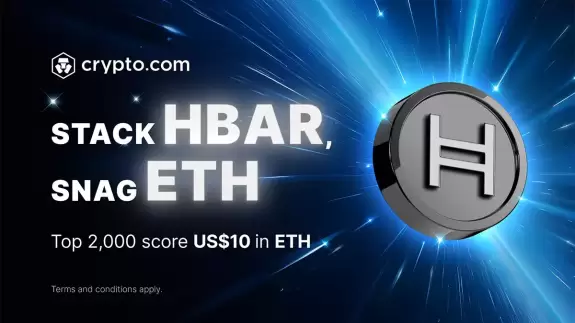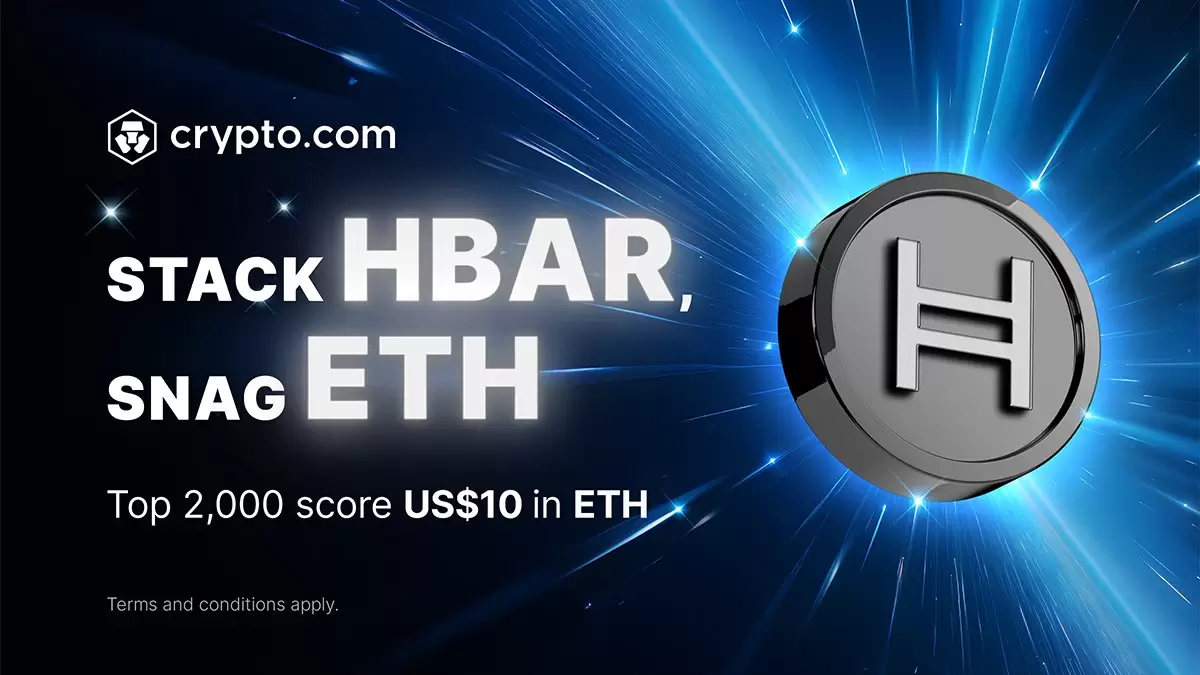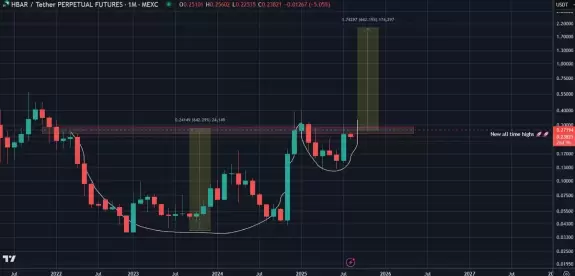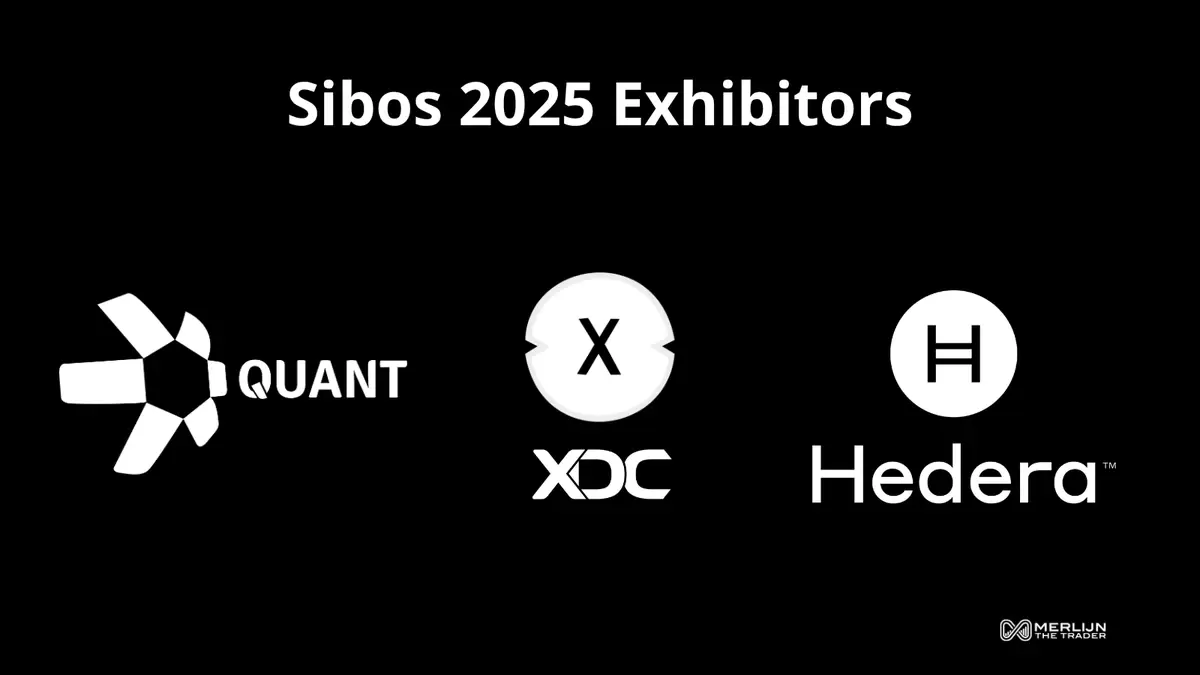All-time High
All-time Low
Volume(24h)
426.7M
Turnover rate
4.05%
Market Cap
10.5248B
FDV
12.4B
Circulating supply
42.39B
Total supply
50B
Max supply
50B
Website
Explorers
Currency Calculator
{{conversion_one_currency}}
{{conversion_two_currency}}
| Exchange | Pairs | Price | Volume (24h) | Volume % | Confidence | Liquidity Score | Earn |
|---|---|---|---|---|---|---|---|
| {{val.marketPair}} | {{val.price}} | {{val.volume24h}} | {{val.volumePercent}} | Low Moderate High | {{val.effectiveLiquidity}} | Buy / Sell | |
Community sentiment

26%
74%


Bullish

Bearish
 A week left to rise up the ranks Top 2,000 users ranked by Net Gains get US$10 of $ETH! Qualify by depositing or buying US$50+ of $HBAR
A week left to rise up the ranks Top 2,000 users ranked by Net Gains get US$10 of $ETH! Qualify by depositing or buying US$50+ of $HBAR  Details and T&Cs
Details and T&Cs  https://crypto.com/events/hbar-app-campaign…
https://crypto.com/events/hbar-app-campaign… 
| Exchange | Pair | Price | Volume (24h) | Volume % | Confidence | Liquidity Score | Earn |
|---|---|---|---|---|---|---|---|
| {{val.marketPair}} | {{val.price}} | {{val.volume24h}} | {{val.volumePercent}} | Low Moderate High | {{val.effectiveLiquidity}} | Buy / Sell | |
About Hedera
Where Can You Buy Hedera Hashgraph (HBAR)?
HBAR is a popular digital asset that is available to trade on several prominent exchange platforms, including [Binance](https://coinmarketcap.com/exchanges/binance/), Bittrex and [Huobi Global](https://coinmarketcap.com/exchanges/huobi-global/). Some of the more popular HBAR trading pairs include HBAR/USDT, HBAR/BTC and HBAR/ETH, and there are also several fiat trading options for the cryptocurrency, including HBAR/USD, HBAR/KRW and HBAR/INR. For more information about buying cryptocurrencies with fiat, see our [comprehensive guide](https://coinmarketcap.com/how-to-buy-bitcoin/).
How Is the Hedera Hashgraph Network Secured?
Hedera Hashgraph uses a novel consensus system known as Hashgraph consensus to keep its network secure. This uses a rotating governing council consisting of up to 39 highly diversified organizations that span across up to 11 different industries. These are involved with directing the Hedera codebase, voting on platform decisions and operating the initial nodes on the Hedera public network. Hedera uses a novel form of [proof-of-stake](https://coinmarketcap.com/alexandria/article/proof-of-work-vs-proof-of-stake) (PoS) which allows HBAR users to stake their resources to help protect the network. Right now, all Hedera nodes are managed by either Hedera itself or the governing council members, but there are plans to switch to a permissionless system in the future. \ Overall, Hedera's security setup ensures it achieves "asynchronous” [Byzantine fault tolerance](https://coinmarketcap.com/alexandria/glossary/byzantine-fault-tolerance-bft) (ABFT) — meaning it can guarantee both the timing and order of a set of transactions, even if some data is delayed or lost.
How Many Hedera Hashgraph (HBAR) Coins Are There in Circulation?
The Hedera Hashgraph token, HBAR, has a maximum total supply of 50 billion units. Out of this, almost seven billion were in circulation as of January 2021 — equivalent to around 14% of the total supply. Hedera publishes regular reports detailing when the next wave of HBAR tokens will be unlocked. These reports can be viewed [here](https://help.hedera.com/hc/en-us/articles/360002789198-When-are-the-next-distributions-of-hbars-scheduled-). According to [Hedera's resources](https://help.hedera.com/hc/en-us/articles/360007177217-How-is-Hedera-management-compensated-#breadcrumb), the two project founders each have a coin grant of two billion HBARs, equivalent to 4% of the total supply each. These tokens are vested over a six-year period. Other senior executives at Hedera (that joined prior to 2018) have coin grants of between 250 million and 300 million coins. These tokens are vested over a period that ends in December 2021. According to Hedera's [Economics Whitepaper](https://hedera.com/blog/new-v3-of-the-hbar-economics-whitepaper) (published June 2020), around 17.03 billion HBAR is estimated to be in circulation by 2025 — equivalent to 34% of the total supply.
What Makes Hedera Hashgraph Unique?
Unlike most other cryptocurrency platforms, Hedera Hashgraph isn’t built on top of a conventional [blockchain](https://coinmarketcap.com/alexandria/glossary/blockchain). Instead, it introduces a completely novel type of distributed ledger technology known as a Hashgraph. This technology allows it to improve upon many blockchain-based alternatives in several key areas, including speed, cost, and scalability. Hedera transactions have an average transaction fee of just $0.0001 USD and typically reach finality in under five seconds. Overall, Hedera Hashgraph claims it can handle more than 10,000 transactions per second (TPS) — compared to the around 5-20 for most popular proof-of-work (PoW)-based blockchains. The platform offers several major network services. These include: * A token service that allows users to easily configure and mint both fungible and non-fungible tokens ([NFTs](https://coinmarketcap.com/alexandria/glossary/non-fungible-token)) on Hedera with just a few lines of code. * A [consensus](https://coinmarketcap.com/alexandria/glossary/consensus) service that acts as a layer of trust for any application or network that needs a secure, verifiable log of events. * Smart contract tools that let developers build powerful and efficient decentralized applications. * Decentralized file storage services with features include proof-of-deletion, controlled mutability, and time-based file expiry.
Who Are the Founders of Hedera Hashgraph?
Hedera Hashgraph has two founders: Dr. Leemon Baird and Mance Harmon. Dr. Leemon Baird is credited as the investor of the hashgraph distributed consensus algorithm and currently works as Hedera's chief scientist. Prior to founding Hedera Hashgraph, Baird accumulated more than a decade of experience in various computer science and security roles and previously worked as a senior research scientist at the Academy Center by Cyberspace Research. He also holds the position of co-founder and CTO at Swirlds Inc., a platform for building DApps. On the other hand, Mance Harmon is Hedera’s CEO and an experienced technology executive and seasoned entrepreneur. Harmon has around two decades of experience holding executive roles at prominent firms — many of which are in the IT security industry. Like Dr. Leemon Baird, Mance Harmon also holds a second position at Swirlds Inc., as its co-founder and CEO. In addition to the founders, the Hedera leadership team also comprises more than a dozen individuals, many of which have had distinguished careers.
What Is Hedera (HBAR)?
Hedera is the most used, sustainable, enterprise-grade public network for the decentralized economy that allows individuals and businesses to create powerful decentralized applications ([DApps](https://coinmarketcap.com/alexandria/glossary/decentralized-applications-dapps)). It is designed to be a fairer, more efficient system that eliminates some of the limitations that older blockchain-based platforms face — such as slow performance and instability. It was funded through an initial coin offering (ICO) in August 2018 and first launched open access to its mainnet just over a year later in September 2019. As part of the ICO, investors were able to purchase the platform’s native utility token (HBAR) at the lowest possible pricing. The HBAR token has a dual role within the Hedera public network. First and foremost, HBAR the fuel that powers Hedera services, such as [smart contracts](https://coinmarketcap.com/alexandria/glossary/smart-contract), file storage and regular transactions. Second, it's used to help secure the network, since HBAR users can [stake](https://coinmarketcap.com/alexandria/glossary/staking) their tokens to assist with maintaining the integrity of the platform. Hedera (HBAR) is the native cryptocurrency of Hedera Hashgraph, a platform that is positioned as an alternative to traditional blockchain technology and aims to excel in speed, efficiency and security. Older blockchains tend to use a consensus mechanism like proof-of-work ([PoW](https://coinmarketcap.com/alexandria/article/proof-of-work-vs-proof-of-stake)) to validate transactions, while younger blockchains opted for proof-of-stake ([PoS](https://coinmarketcap.com/alexandria/article/proof-of-work-vs-proof-of-stake)). The Hedera Hashgraph system has a structure that was created from scratch particularly for the project. Hedera is based on a PoS model that is believed to increase the efficiency of transaction verification in the network, provide a high level of security, and protect the network from hacker attacks. Its ecosystem has the underlying hashgraph consensus algorithm and the global enterprise governing body. Hedera Hashgraph is a distributed ledger technology (DLT). According to the project website, Hedera differs from other blockchains because it uses a new consensus algorithm called hashgraph. It intends to process and execute transactions faster, eliminate delays, and smooth out the TPS (transactions per second) indicator. Hashgraph is claimed to be an upgrade in transaction speed, cost, and scalability. Core network services by Hedera: Consensus Service (HCS). With HCS, clients send messages to the network to negotiate consensus timestamping and order. In this case, the state is stored offline, and users can define privacy and access control. Hedera Token Service (HTS). Thanks to HTS, token creation and management are available to customers. It supports built-in tokenization. The goal of Hedera’s hashgraph is to increase the speed of transactions. Moreover, the network is also focused on high-volume operations: micropayments, data integrity and tokenization. Like the EVM, the Hedera network maintains a virtual machine that writes smart contracts in the Solidity programming language. On top of that, Hedera offers a set of built-in [KYC](https://coinmarketcap.com/alexandria/glossary/kyc) and [AML](https://coinmarketcap.com/alexandria/glossary/anti-money-laundering) checks. From a technical point of view, Hedera is a form of distributed ledger technology. It is a hashgraph, or consensus algorithm, where users agree on the order in which transactions should be performed. However, Hedera is not exactly a blockchain. It has its own distinctiveness and works differently. With hashgraph, all transaction branches are merged, no block equivalent is thrown away, and each is used to reach consensus. One of the most noticeable features of the network is the Gossip-about-Gossip protocol. According to Dr. Leemon Baird, Hedera's inventor, within the system nodes randomly transmit data about themselves to other nodes via hashgraph using the Gossip protocol. Soon, all nodes in a cluster become familiar with each other. Then a certain data structure is formed. It consists of a payload of transactions, a timestamp, a digital signature, and hashes to the previous structures. HBAR is Hedera's native token that powers applications on the Hedera network. HBAR is utilized to pay for network services, transaction fees, in-app payments and micropayments. Developers can pay network fees with HBAR tokens, namely: work with [smart contracts](https://coinmarketcap.com/alexandria/glossary/smart-contract), file storage and currency exchange. HBAR is used to incentivize and pay network nodes. Hedera Hashgraph has a decentralized governance system that is set apart. All critical decisions about pricing policy, software updates, and wealth management are made by the Governing Council.
Hedera News
-

The stablecoin market is heating up. Paxos, Circle, and Ripple are all vying for national trust charters amid evolving regulatory landscapes.
Aug 12, 2025 at 12:01 am
-

Bitcoin's dominance is wavering, and altcoins are surging. Discover the top altcoins with the potential for NYC-level returns. Is now the time to invest?
Aug 11, 2025 at 11:46 am
-

Hedera (HBAR) flashes a golden cross, hinting at a potential surge. Will it reach $0.50? Dive into the bullish trend and what analysts are saying.
Aug 11, 2025 at 03:46 am
-

JPMorgan's optimistic outlook on U.S. stocks, even amid economic concerns, is driving the S&P 500 higher. Is this rally sustainable, or are we ignoring key risks?
Aug 10, 2025 at 11:51 pm
-

Bitcoin's 2025 is looking stellar! From YTD gains outpacing major assets to a staggering total return since 2011, let's dive into what's driving Bitcoin's performance.
Aug 10, 2025 at 05:56 am
-

Exploring BlockDAG, Stellar, and their impact on crypto adoption. Is BlockDAG's presale buzz justified? How are Stellar's real-world applications shaping the future?
Aug 09, 2025 at 01:57 pm
-

HBAR's recent price surge and market cap milestones have investors buzzing. This blog explores the factors behind the rise and what the future might hold.
Aug 09, 2025 at 05:31 am
-

Explore the surge in cold wallet demand, Hedera's Robinhood listing impact, and Ethena's price rally. Discover key trends shaping the crypto market in 2025.
Aug 05, 2025 at 07:10 pm
-

Spartans is shaking up the crypto casino scene with instant payouts, a 300% bonus, and a massive game library. Forget speculative assets, Spartans delivers real value now.
Aug 04, 2025 at 11:57 am
Similar Coins



















































































Twitter
GitHub
Close